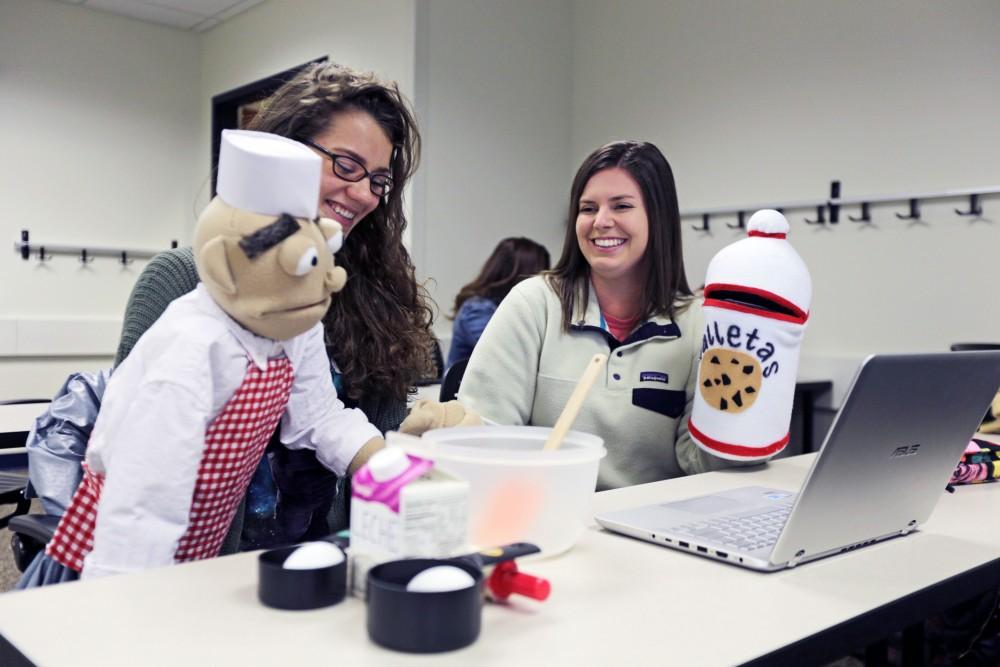Students learn Spanish through puppetry class

GVL / Emily Frye Kendra Marckini and Caitlin Hennessy practice their puppet skit for their upcoming performance on Wednesday March 21, 2018.
Mar 29, 2018
On any given Monday or Wednesday afternoon this semester, in the D wing of Mackinac Hall, you can find 12 students spread across their classroom and the neighboring Language Resource Center rehearsing original Spanish scripts and acting with homemade puppets. In the background of the classroom, associate professor Jason Yancey plays lively Spanish pop music while moving from group to group to check in on students’ rehearsals and answer questions. In the LRC, students practice performing behind the curtain of a puppet stage, seemingly uninhibited by any anxiety of rehearsing in front of students there for other classes.
This is Spanish Laboratory Theatre, a 300-level hybrid elective for students who want to improve their language skills in a unique way, replacing academic papers with creative scripts, puppet building and live performances in front of elementary and college students.
“For me, this is not a theater class,” Yancey said. “This is not about making them puppeteers. It’s not about making them actors. It’s about helping them overcome the anxiety that they might feel when they have to speak to someone in Spanish.”
When Yancey first started teaching the class at Grand Valley State University in 2010, he discovered that the props and resources immediately available for his students to use were practically nonexistent. Drawing on his own unique expertise in theater, including behind-the-scenes building and production, he brought in his own props, which he continues to use, including the stage for performances that he has modified and updated over time.
During rehearsals, students are also able to use puppets from his personal collection as stand-ins before building their own. Over the years, Yancey has amassed a collection of more than 200 homemade puppets.
“I don’t usually buy puppets,” he said. “It’s like buying somebody else’s kid. … Many times I build puppets because I want to try something new, because I have a new idea.”
As part of the class, students create their own puppets that they later use to perform in front of students at local Spanish-immersion elementary schools. Despite the students only spending about a week putting their puppets together, the final products are remarkably detailed and well-constructed.
“I spent 12 hours five days a week over spring break making this,” said Kendra Marckini, holding up her wide-mouth foam puppet. “I put my heart and soul into this guy.”
Felipe Gonzalez III, a baker in a white button-down shirt and red gingham apron, is made from foam and fabric and held together by stitches and glue.
“This was my first time sewing ever,” Marckini joked. “My mom had to show me how to use a sewing machine and how to do stitches. I burned my hand on glue. I’ve been stabbing myself all over.”
Yancey said the benefit of requiring the students to build their own puppets is that the hard work they put into the process ensures that they are personally invested in the overall project.
“I find that having them build a puppet means that they care,” he said. “If I just had them buy a puppet or rent one, I don’t think they’d care as much. I think they’re proud to share the work that they did. … They’re making all these creative choices.”
While building the puppets was no easy task, the most challenging part of the creative process for some students was writing scripts that would appeal to young audiences.
Alison Keaser had to modify her script so that it wouldn’t be “too childish.”
“Kids actually don’t like when you are kind of talking down to them,” she said. “They like violence. Things you wouldn’t think the kids like, they want in a play.”
One of the benefits of learning Spanish through puppetry, Yancey said, is that the puppets shoulder the blame for grammar mistakes and other errors, not the students.
“If they can do a silly voice in front of a whole group of kids, then all the sudden, talking to someone on the street and asking directions is not such a big deal, and the puppet becomes kind of a stunt double that takes all the heat and all the criticism,” he said. “If I don’t conjugate a verb correctly, it’s the puppet’s fault. It’s not my fault.”
Yancey’s students agree.
“Honestly, I think it’s way easier to be behind a curtain because … it is the puppet making any grammar mistakes or going in the wrong direction or doing things wrong—it’s not you,” said Caitlin Hennessy, a student in the class.
For student Katie Zerkle, working with puppets is helping her prepare for a much bigger enterprise: studying abroad.
“(Yancey) talked about, well, if you want to study abroad, this is one way to boost your confidence,” she said. “If you can change your voice and make a presentation with a puppet in Spanish, if you’re abroad, you can easily go up to someone and start a conversation. And I plan on studying abroad in Spain next winter for six months, actually. … This will help me be comfortable speaking.”
Yancey said the university has been overwhelmingly supportive of the class and has funded equipment for it as well.
“I’m very, very fortunate that Grand Valley likes what I’ve been doing and has financially supported it for years,” he said. “As much work and as much headache and stress as it is, it’s why I do what I do. And I’m very fortunate that Grand Valley sees that, too.”
The Spanish Laboratory Theatre students will be performing their eight-minute shows at GVSU on Friday, April 6, at 7 p.m. in Manitou Hall 122 and again on Monday, April 9, at 1:30 p.m. in the Linn Maxwell Keller Black Box Theatre. The shows are free and open to the public.

























